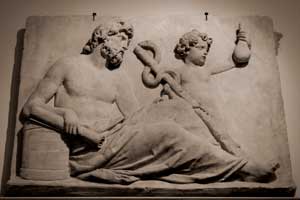The following articles have been published as part of the special collection, ‘Healing Gods, Heroes and Rituals in the Graeco-Roman World’, edited by Professor Panayotis Pachis (Aristotle University of Thessaloniki). The first two articles in this collection interrogate the figures of specific healing gods. Olympia Panagiotidou’s article ‘Asclepius’ Myths and Healing Narratives: Counter-Intuitive Concepts and Cultural Expectations’ focuses on the curative features that defined the image of Asclepius, the most famous of the healing gods. The next article in the collection, ‘The Fate of a Healing Goddess: Ocular Pathologies, the Antonine Plague, and the Ancient Roman Cult of Bona Dea’ by Leonardo Ambasciano, interrogates the religious figure of another healing agent: the Italian goddess Bona Dea who was particularly venerated in Rome and in the region of Latium and whose cult reveals the way in which ancient Roman androcentric control over women was institutionalised through religious figures.
The third article in the collection, Audrey Ferlut’s ‘Goddesses as Consorts of the Healing Gods in Gallia Belgica and the Germaniae: Forms of Cult and Ritual Practices’ considers the impact that cults dedicated to gods and goddesses had on populations in the wider area of the Roman Empire, focusing on the Northern provinces of the Western Roman Empire (Gallia Belgica and the Germaniae). The collection’s final article, ‘From Textual Reception to Textual Codification: Thessalos and the Quest for Authenticity’ by Spyros Piperakis, moves the discussion from the question of cult practices to ‘alternative’ healing therapies in antiquity. Piperakis deals with astrological medicine, one of many alternative therapeutic methods that became popular during the Hellenistic and Roman period.
Taken together, the articles in ‘Healing Gods, Heroes and Rituals in the Graeco-Roman World’ demonstrate that we need to approach the study of ancient myths and cults within their socio-cultural context. These articles thus challenge traditionalist approaches to the history of religion and reveal the richness of interdisciplinary approaches in the twenty-first century: offering new paths of inquiry that could help us to extract new data and shape a new interdisciplinarity in the current and future research of the religions and cults of Antiquity.
Editorial
Healing Gods, Heroes and Rituals in the Graeco-Roman World
Panayotis Pachis
2016-05-10 Volume 2 • Issue 1 • 2016 • e14
Also a part of:
Special Collection: Healing Gods, Heroes and Rituals in the Graeco-Roman World
Healing Gods, Heroes and Rituals in the Graeco-Roman World
Special Collections
-
Diversity and Competition within the Latin Church: The Secular-Mendicant Controversy and its Long Aftermath (13th–20th Centuries)
Thinking the Political: Theory, Literature, Practice
Poetry Off the Page: Intersecting Practices and Traditions in British Poetry Performance
Humour as a Human Right
Cultural Heritage Data for Research: Opening Museum Collections, Project Data and Digital Images for Research, Query and Discovery
Literature as Imaginary Archive: Ephemera and Modern Literary Production
Caliban's Mirror: Reflections of James Joyce and Oscar Wilde
Cultural Representations of Machine Vision
The Public Curatorship of the Medieval Past
Medieval Minds and Matter
Representing the Medieval in Popular Culture: Remembering the Angevins
The Politics and History of Menstruation: Contextualising the Scottish Campaign to End Period Poverty
Production Archives 03: Archival Practices
Production Archives 02: Production Contexts
Production Archives 01: Puppets for Action
Representing Classical Music in the Twenty-First Century
The Pathological Body: European Literary and Cultural Perspectives in the Age of Modern Medicine
Binary Modernisms: Re/Appropriations of Modernist Art in the Digital Age
Local and Universal in Irish Literature and Culture
Reading in Ruins: Exploring Posthumanist Narrative Studies
The Language of Perspective
Nancy Astor, Public Women and Gendered Political Culture in Interwar Britain
The Working-Class Avant-Garde
Colonialities in Dispute: Discourses on Colonialism and Race in the Spanish State
Powering the Future: Energy Resources in Science Fiction and Fantasy
Writers and Intellectuals on Britain and Europe, 1918–2018
Literature, Law and Psychoanalysis
Muslims in the Media
Encounters between Asian and Western Art in the 20th and 21st centuries: a liberating influence for Asia?
Waste: Disposability, Decay, and Depletion
Pride Revisited: Cinema, Activism and Re-Activation
New Approaches to Late Medieval Court Records
Utopian Art and Literature from Modern India
Right-Wing Populism and Mediated Activism: Creative Responses and Counter-Narratives
Representing Climate: Local to Global
Cultivating Spheres: Agriculture, Technical Communication, and the Publics
Freedom After Neoliberalism
The Medieval Brain
Remaking Collections
New Approaches to Medieval Water Studies
Imaginaries of the Future 01: Bodies and Media
Imaginaries of the Future 02: Politics, Poetics, Place
Imaginaries of the Future 03: Utopia at the Border
Postcolonial Perspectives in Game Studies
Station Eleven and Twenty-First-Century Writing
#Agreement20
What’s Left? Marxism, Literature and Culture in the 21st Century
New Voices in Jewish-American Literature
Authors, Narratives, and Audiences in Medieval Saints’ Lives
From TV To Film
American Literature & the Transnational Marketplace
Mnemosyne
Healing Gods, Heroes and Rituals in the Graeco-Roman World
The Abolition of the University
